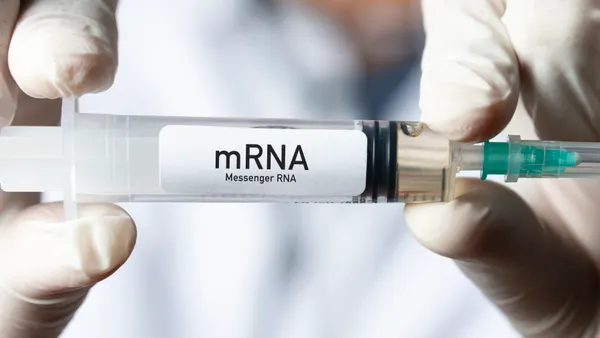 Open access and crowdsourcing scientific information to accelerate research and development requires a new way of thinking about how clinical research is conducted and breaking down competitive barriers for the greater good.
Open access and crowdsourcing scientific information to accelerate research and development requires a new way of thinking about how clinical research is conducted and breaking down competitive barriers for the greater good.
Crowdsourcing is the process of getting work or funding, usually online, from a crowd of people. This mainstream social experiment, which has been popularized by such funding sites as indiegogo and Kickstarter, is now being implemented in the traditionally siloed framework of clinical research. Social networks, such as PatientsLikeMe, are connecting patients to share healthcare and treatment information and networks for physicians such as Sermo are bringing together physicians in virtual online meeting places that facilitate discussions, online learning, and medical information sharing. And in academia, crowdsourcing has been used for more than a decade for data mining, to solve issues related to computational problems, and to screen for therapeutic effect of compounds against targets.
For pharmaceutical companies, crowdsourcing has taken the form of “open innovation." Companies such as AstraZeneca, Lilly, GSK, Janssen, Merck, Pfizer, Sanofi, TransCelerate, and others have launched initiatives to enable scientific innovation to cross boundaries between companies, academia, government, and nonprofit organizations.
Additionally, these and other companies have developed challenges or competitions for researchers to apply for grants for new research projects.
Art Olson, Ph.D., professor, department of Integrative Structural and Computational Biology at The Scripps Research Institute, agrees that as part of the social aspect to crowdsourcing, many sites offer badges and recognition.
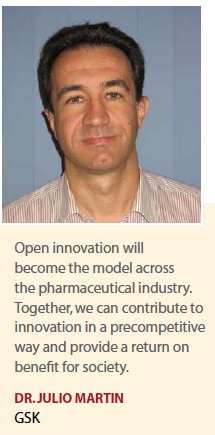 “This is a new paradigm and a new business model," says Julio Martin, Ph.D., head of Parasite Chemotherapy at GSK. “Open innovation will become the model across the pharmaceutical industry. Together, we can contribute to innovation in a precompetitive way and provide a return on benefit for society."
“This is a new paradigm and a new business model," says Julio Martin, Ph.D., head of Parasite Chemotherapy at GSK. “Open innovation will become the model across the pharmaceutical industry. Together, we can contribute to innovation in a precompetitive way and provide a return on benefit for society."
GSK approaches open research by providing opportunities for researchers to access the company’s processes and facilities. Through its not-for-profit Tres Canto Open Lab Foundation, the company brings together academic and other organizations for projects related to diseases of the developing world.
“This foundation is funding research scientists who are visiting us from research labs around the world to develop their own projects," Dr. Martin says. “These are investigators who may already have their own funds, and they come to us as a partner to conduct research that might not be possible in their own labs. We also have compounds with certain activity against parasites, and we are putting these forward in the public domain for anyone in the research community who would be willing to pursue these compounds."
The concepts of crowdsourcing and open innovation are still finding their footing throughout the industry. Among the 12 largest biopharmaceutical companies’ R&D pipelines in 2014, just under one in five drugs was sourced through collaborations and none were through open source, according to a Deloitte analysis. There are several factors inhibiting adoption, according to Deloitte analysts, including new workflows and processes and a generalized skepticism about open models. Concerns about intellectual property are also another limiting factor.
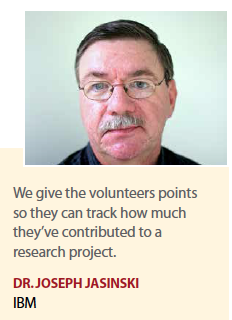 At the same time, these analysts say biopharmaceutical companies’ reliance on a closed, traditional model of product development could stifle true innovation and cause companies to lag behind more creative competitors. Adopting a more open framework provides researchers with access to a diverse pool of ideas that could spur innovation, speed time to market, reduce costs, and increase competitiveness. According to Deloitte, there is a three-fold probability of success when drugs are sourced through an open process.
At the same time, these analysts say biopharmaceutical companies’ reliance on a closed, traditional model of product development could stifle true innovation and cause companies to lag behind more creative competitors. Adopting a more open framework provides researchers with access to a diverse pool of ideas that could spur innovation, speed time to market, reduce costs, and increase competitiveness. According to Deloitte, there is a three-fold probability of success when drugs are sourced through an open process.
Susan Garfield, DrPh, a principal in the life-science advisory practice at EY, says in her conversations crowdsourcing has become a topic of discussion as a way to tap into and increase the innovation pipeline, decrease the cost of development, and put the patient at the center of research and development.
“This is especially true within orphan and rare disease areas," she says. “When populations of patients are small, crowdsourcing has been discussed as a way to help understand the patient experience, the disease pathway and progression, and elements of a disease that we may not be able to capture in the historical R&D environment."
Dr. Garfield says crowdsourcing can help change the research paradigm and shift the thinking that research needs to be done one study, one disease at a time.
“With crowdsourcing, companies could begin to study in more detail the experience of constellations of symptoms of diseases and comorbidities, for example people who have diabetes who also have cardiac disease," she says. “With these types of comorbidities, it’s always been challenging to understand the interdependencies when we start looking at bigger populations. Crowdsourcing offers an opportunity — but also challenges — to answer questions that are relevant to health outcomes."
In addition to the focus on improving health outcomes, crowdsourcing is being driven by the increasing adoption of mobile computing.
“With more than 2 billion smartphones and advances in biosensors, crowdsourcing will benefit through the automatic collection of billions and billions of data about the human condition," says Marc Desgrousilliers, chief technology officer at Clinovo.
However, Dr. Garfield cautions that crowdsourcing without science is risky.
“Patient feedback is helpful if it is representative of the patient population," she says.
Another issue regarding crowdsourcing is around the quality of the data.
“There is a note of caution in that more data isn’t always good and volume doesn’t always equal quality," Dr. Garfield says.
Dr. Garfield is hopeful crowdsourcing will be able to provide pharma companies with access to patients faster, as well as to help identify problems faster, which can hasten the pace of innovation.
“If we have more information going into trial design and product design, then we will be able to develop better products at a faster pace, which will provide better value to the healthcare system," she says.
Stephen Clulow, Ph.D., director of healthcare program management, NineSigma, says taking advantage of open innovation requires companies to change their business models and processes to accommodate new ways of doing things.
“One mistake people make about open innovation is they think it’s all about what goes on outside the company," he says. “They think it’s about writing down a challenge, finding a good way of distributing it to people, and gathering the responses. And they think if they can do that well, they will be successful. Only about 40% of crowdsourcing is about what happens outside the company."
Games and Competitions
Some crowdsourcing efforts use community challenges, open forums, or games to encourage participation in pharmaceutical research and clinical trials. Dr. Clulow points out that there have been successes in this space. For example, Foldit, uses the crowd to look at how different proteins fold.
Foldit, a protein folding game with more than half a million registered players, has dramatically improved protein folding algorithms. Foldit’s goal is to predict the structure of a protein through puzzle-solving scenarios, which would aid the creation of designing new proteins to combat disease-related proteins found in HIV/AIDS, cancer, or Alzheimer’s, for example.
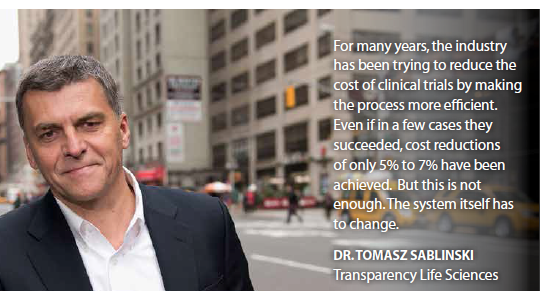 Foldit was developed by the Center for Game Science at the University of Washington, which focuses on solving hard problems facing humanity in a game-based environment. The Center for Game Science is gearing to launch FolditTV, to share protein-folding knowledge the community has gained over the years with a much larger audience.
Foldit was developed by the Center for Game Science at the University of Washington, which focuses on solving hard problems facing humanity in a game-based environment. The Center for Game Science is gearing to launch FolditTV, to share protein-folding knowledge the community has gained over the years with a much larger audience.
Another crowdsourcing game was last year’s challenge by the American Epilepsy Society. The Seizure Detection Challenge was launched on the website Kaggle.com, an online platform for data prediction competitions. The challenge involved two distinct contests: detection and prediction of seizures. A total of 504 teams from all over the world participated in both contests.
The teams analyzed a huge data set detailing the electrical activity in the brains of people while under evaluation for surgery to treat their epilepsy. They also had an even larger data set from studies with dogs, whose epilepsy closely resembles that evidenced in people.
In the detection contest, the team that identified the earliest changes in brain activity that led to a seizure with the fewest false alarms took home the prize. In the prediction contest, the team that generated a predictive signature of changes in brain activity that led to a seizure with the fewest false alarms won.
Another crowdsourced project is DIYgenomics, a nonprofit research organization interested in the realization of personalized medicine through crowdsourced health initiatives. In this effort, people submit their DNA for a particular research project to look for genetic determinants.
“There is a lot of interest in how our individual genome influences our chance of getting a disease," Dr. Clulow says.
Several DIYgenomics crowdsourced research studies are currently in process, particularly for vitamin deficiency, aging, and mental performance. The hypothesis is that one or more genetic mutations may result in phenotypic biomarker conditions, for example, low vitamin D blood levels, and that personalized intervention may improve this.
Even patient organizations are beginning crowdsourcing initiatives. For example, in August, The Myeloma Crowd Research Initiative (MCRI), a collaboration of cancer researchers and patient advocates, announced the two winners of its first crowdsourcing and patient-led initiative to fund research in high-risk multiple myeloma, a rare malignancy of plasma cells. MCRI pledged up to $500,000 over two years for both grants combined.
The winners are a team of researchers from the University of Wurzburg, Germany, and the Johns Hopkins Sidney Kimmel Comprehensive Cancer Center. Research at the University of Wurzburg will focus on genetically engineered receptors on a type of white blood cells, called CAR T-cells, to attack two specific targets found on myeloma cells and not found on normal cells. The therapy developed would be a one-time treatment and not used with transplant or other combination therapies. Researchers at Johns Hopkins are working on enhancing white blood cells to create a patient-specific immunotherapy. Using the patients’ own bone marrow, the therapy expands the immune fighting cells a hundred-fold in the presence of the tumor cells. When given back to the patient, the training helps T-cells go after hundreds of tumor-specific signatures and takes advantage of the body’s natural immune cell regrowth post-transplant.
Another example of a challenged sponsored by a patient group is the Clinical Trial Innovation Prize, sponsored by the Bonnie J. Addario Lung Cancer Foundation and Free to Breathe. In August, the winners of the first phase were announced. The Clinical Trial Innovation Prize consisted of a worldwide search of novel ideas on how to double the accrual rate of cancer trials. More than 100 innovators and 14 teams participated in the Challenge from all over the world, with submissions coming in from Israel, Nigeria, Germany, India, United States, and 13 other countries.
First prize went to Helynx, a start-up out of Caltech, UCLA, and Harvard, and Dr. Jae Kim, a cardiothoracic surgeon at City of Hope, a research and treatment center for cancer and other life-threatening diseases. They teamed up to create a system for automatically matching patients to the clinical trials for which they qualify using machine learning techniques to read patients’ electronic health records to determine eligibility. This program will be piloted at the 13 community centers affiliated with City of Hope in California. The winning entry received $20,000.
Crowdsourcing Drug Discovery
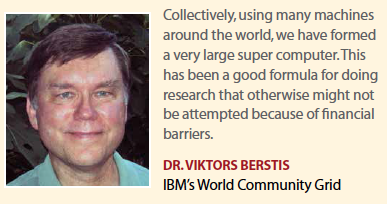 Crowdsourcing efforts in drug discovery aim to use the power of the crowd to look for potential hits and screen molecules against targets. One such effort is World Community Grid, which was conceived and is managed by IBM.
Crowdsourcing efforts in drug discovery aim to use the power of the crowd to look for potential hits and screen molecules against targets. One such effort is World Community Grid, which was conceived and is managed by IBM.
Hosted on IBM’s SoftLayer cloud technology, World Community Grid provides free computing power to scientists by harnessing the unused, surplus cycle time of a number of volunteers’ computers and mobile devices from all over the globe. World Community Grid software receives, completes, and returns small computational assignments to scientists.
Volunteers download a program from the site that runs in the background. When the volunteer’s computer is not doing anything else it can work on a small piece of a bigger research problem.
“Collectively, over many machines around the world that donate their space and time this way, we form a very large super computer," says Dr. Viktors Berstis, lead scientist for the World Community Grid. “We give this computing power to researchers free of charge. It’s been a good formula for getting research done that otherwise might not be attempted because of financial barriers."
Dr. Berstis says the Grid was created in 2003 after a small test study to screen for drug candidates for small pox. Since then, more than 3 million computers and mobile devices used by about 700,000 people globally and 460 institutions from 80 countries have contributed virtual supercomputing power.
“People around the world are interested in science and health," says Joseph Jasinski, Ph.D., an engineer and executive for IBM’s Smarter Healthcare and Life Sciences division. “People can volunteer their machine for whatever purpose or they can pick a specific project to work on. People form teams. We give them points and they track how much they’ve contributed to a research project."
Since the program’s inception, World Community Grid has powered nearly two dozen research projects, donating more than 1 million years of computing time worth $400 million to scientific research and enabled important scientific advances in areas as diverse as cancer research, AIDS treatments, genetic mapping, solar energy, and ecosystem preservation. More than 2.4 billion research tasks have been completed.
It has enabled multiple breakthroughs, such as helping the Chiba Cancer Center in Japan discover seven new drug candidates to fight childhood neuroblastoma.
The Scripps Research Institute’s Fight AIDS@Home project was the second project to be launched on the World Community Grid. FightAIDS@Home, which had been run independently by the Olson Laboratory since 2002, joined the World Community Grid in November 2005. This effort not only aims to discover new drugs, but also increase the knowledge around the structural biology of AIDS. In addition, researchers are studying the mechanisms of multi-drug-resistance that the super bugs of HIV use to escape the current anti-AIDS drugs.
“We haven’t analyzed all of the data yet, but we have had successes from a scientific point of view," Dr. Olson says. “Most of the computations that we’ve run were focused on the HIV protease protein. The project did produce a chemical that could, in fact, be an anti-HIV drug. But market forces are not open to another protease inhibitor similar to those already available."
Dr. Olson says Scripps is now looking for other footholds on the protease protein that could disrupt its function in a different way, attaching at an area that is distant from the active site of the protein.
“We are in collaboration with crystallographers and virologists who have identified and looked at a number of compounds that are currently being evaluated," Dr. Olson says. “We have found new sites and new binders but don’t know how functionally effective they will be."
Scripps has several other projects being researched via the Grid. In June 2011, Scripps submitted a proposal to IBM to create a new project on the World Community Grid. This project is called the Global Online Fight Against Malaria. In December 2014, Scripps began using the World Community Grid to screen chemical compounds to identify new drug leads for treating Ebola.
“In collaboration with the Ollmann-Saphire Lab, we’re focusing on a number of potential targets for Ebola," Dr. Olson says. “The first targets we looked at didn’t have very druggable sites. So now we’ve started on a second target, which is actually a known enzyme, and should be more promising."
Using Specialized Networks
Another concept in open innovation is the ability to tap the resources of a panel of experts. NineSigma, for example, is a network of specialists that was created to address more scientific questions. The group represents multiple disciplines and includes engineers, scientists, analysts, and executives from a variety of fields.
The company was founded in 2000 on the premise that the industry requires an effective means for broadcasting corporate needs to potential solution providers to stay ahead of the technology curve.
The company’s clients post problems as challenges and experts in the network are invited to submit a proposal, Dr. Clulow says.
“Our clients may engage them to do proof-of-principle or pilot experiments," he says. “We target specific experts with particular expertise who might be in universities, small start-up companies, or even large corporations. We help identify potential people who we believe can help. It is much less random, more targeted."
One such project was with GE, which wanted to map breast cancer pathways, specifically those of molecular proteins. GE wanted to understand what was driving breast cancer.
“The company had been using its own network to conduct this research," Dr. Clulow says. “But GE hadn’t been satisfied with the quality of proposals that had been coming through."
Using NineSigma’s network, GE received 500 proposals from 40 countries. From these, the company selected five proposals from universities and small companies, and it awarded them $100 million each. In another example, the International AIDS Vaccine Initiative was looking for ideas on how to stabilize proteins in HIV to stop mutations. The organization received 30 proposals, and three scientists received a total of $1 million.
The Crowdsourced Company
Some forward-thinking companies are experimenting with new ways to tackle some inherent challenges in the development process in a more comprehensive and open way. One such company is Transparency Life Sciences.
Tomasz Sablinski, M.D., Ph.D., founder and CEO of Transparency Life Sciences, believed there had to be a better way.
The most expensive and inefficient part of drug development, he says, is clinical trials, with costs increasing every year. As a result, many potential products that could bring real value to patients are not developed.
“What the industry has been trying to do for many years is to reduce the costs of clinical trials by 5% or 7%, outsourcing to India or China and trying to make the process more efficient," he says. “But this is not working. The system has to change. I tried to effect change from within the system for a number of years, but I came to the realization that the system cannot be changed from within."
That’s why he founded Transparency Life Sciences in 2011 as a new type of company that develops therapies in a transparent way through a crowdsourced Web platform, which allows patients, physicians, researchers, and other stakeholders to contribute to the design of clinical studies, along with the use of digital and telemedicine technologies for patient data collection.
“I started this company based on three principles, all of which are contrary to how the system operates today," he says. “The first is transparency. Everything we do is open to the extent that is possible by legal, privacy, and other constraints. That includes design of the experiments, conduct of the clinical trials, publishing results, and being completely open about what happens at the front and at the back end.
“The second principle is truly engaging end users and stakeholders — including patients, prescribing physicians, researchers, and scientists — in designing trials done through structured crowdsourcing," he continues. “The third significant element of the model is moving trials to where patients are instead of moving patients to the clinical trial sites. We are doing this via increasingly available services of telehealth or telemedicine, wearable devices, and video visits."
Dr. Sablinski says he expects this model will have several positive results: easier recruitment of patients in trials, more relevant data, a public that is more engaged with research, and savings of about 80% over today’s current practices.
“Bits and pieces of this model are being incorporated, but I believe there needs to be a comprehensive solution rather than point solutions," he says. “We are pioneering just such a comprehensive solution."
The company’s core business model is to acquire intellectual property of stalled drug candidates. Through the company’s Protocol Builder tool on its website, patients, researchers, physicians, statisticians, and others can provide feedback on trial protocols.
“We ask specific questions regarding the study protocol," he says. “Some questions require a binary ‘yes’ or ‘no’ answer, and some are more elaborate. All questions have a box for a narrative response. The aim is to come to a consensus on endpoints, inclusion-exclusion criteria, monitoring systems, and other devices patients and physicians would use to collect data, as well as the best way to measure outcomes."
Dr. Sablinski points out that traditional key performance indicators — time to recruiting all patients, number of queries, quality of data — are artificial and sometimes unreliable.
“These are very crude measurements of success in clinical development," he says. “We believe our model increases the likelihood of either quickly killing a drug that generally doesn’t have positive benefit risk ratio or quickly advancing it in development with high quality and lower budget."
Dr. Sablinski says the Protocol Builder process has resulted in tremendous feedback. In the case of the company’s multiple sclerosis trial, the process resulted in switching primary and secondary endpoints.
He says to have patients and other stakeholders be truly engaged in clinical research requires more than the feedback of a token patient on an advisory board.
“Patients love this for obvious reasons, particularly patients with rare diseases," he says. “These are patients who, in many cases, have never been asked about what matters to them. Patients with multiple sclerosis wanted something different to be measured. They have given us suggestions on what to measure because it matters to them."
The company combines a crowdsourced protocol process with alternative means for collecting data and uses mobile health technology, biometric readings, and video conferencing to limit patient trips to the study center.
For example, in the multiple sclerosis study, Transparency Life Sciences is partnering with AMC Health, a provider of telemedicine services, to enable video study visits in patients’ homes, which enables remote assessment of a primary multiple sclerosis endpoint.
Transparency Life Sciences is currently conducting a Phase IIa study testing the utility of the ACE inhibitor lisinopril as an adjunctive therapy for multiple sclerosis. The company has received a $1.4 million grant from the National Institutes of Health’s National Center for Advancing Translational Sciences.
In another trial in ulcerative colitis, which began in August 2015, the company aims to assess the feasibility of replacing most conventional patient site visits with data collected using a combination of decentralized methods, including digital measurements, telemonitoring, remote video visits with clinical trial staff, and blood collections by visiting nurses. In addition, the study is the first to allow key clinical endpoint assessments to be made by the subjects’ own gastroenterologists, rather than via designated sub-investigators affiliated with the trial.
Subjects participating in this open-label trial choose whether they prefer to participate in the conventional on-site patient study arm or the remote study arm using decentralized data collection alternatives.
The trial is being conducted in collaboration with Brigham and Women’s Hospital, a teaching affiliate of Harvard Medical School. AMC Health contributed to the design of the ulcerative colitis trial and is deploying its mobile technology to enable video study visits and vital sign collection in patients’ homes. MedPoint Digital is helping to manage patient recruitment, enrollment, electronic informed consent, and endoscopy video data storage for the trial.
“We’ve created a new legal and regulatory framework for procedures to be performed," Dr. Sablinski says. “Some patients included in this pilot trial may never see a principal investigator physically, which is a complete departure from today’s processes, in which patients are sometimes flown to study centers." (PV)











